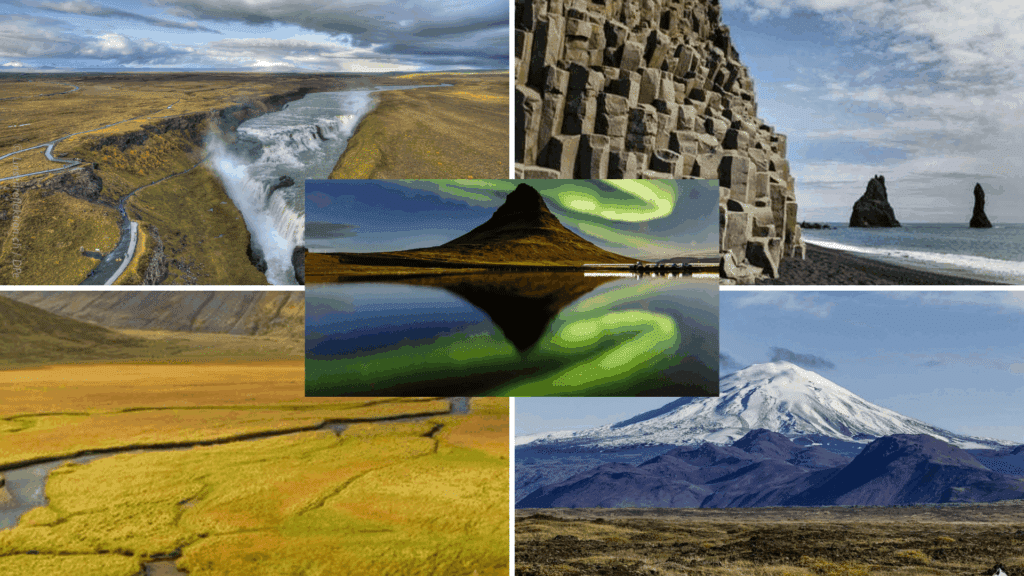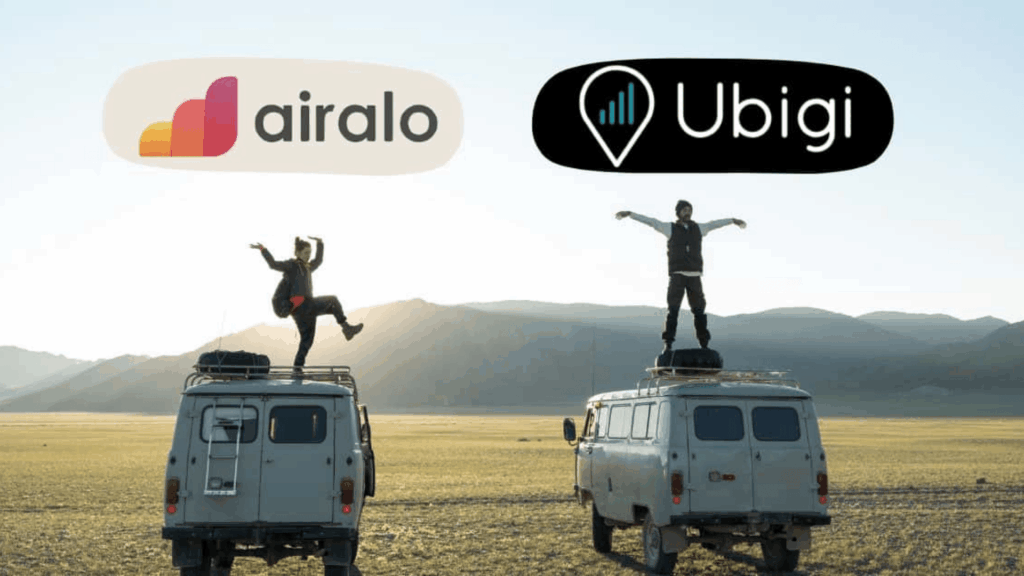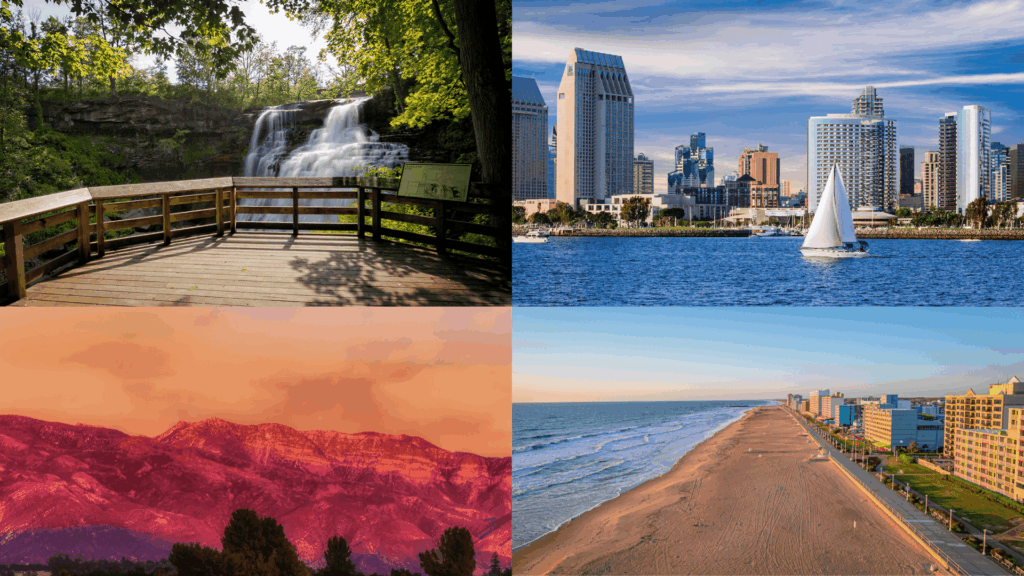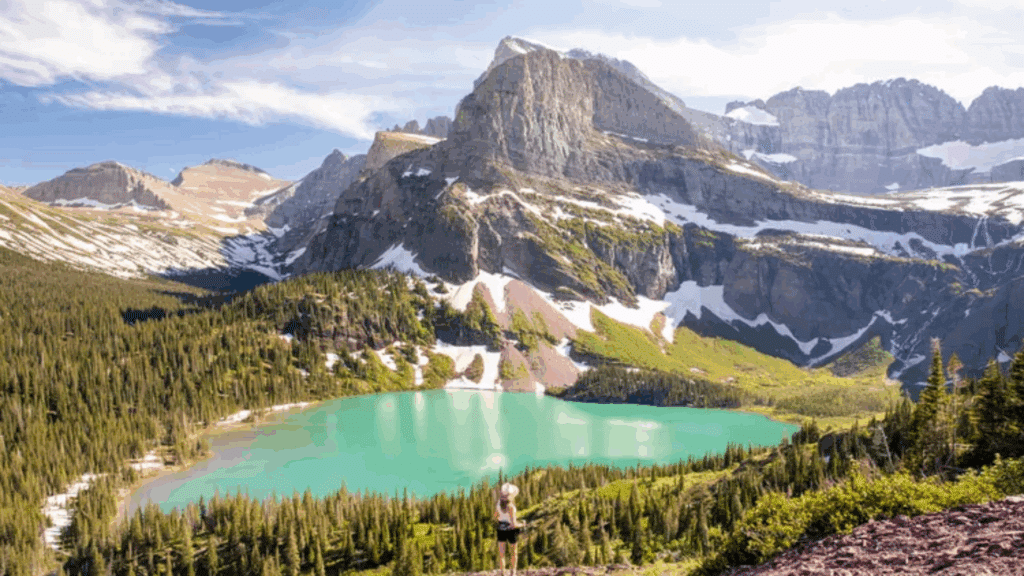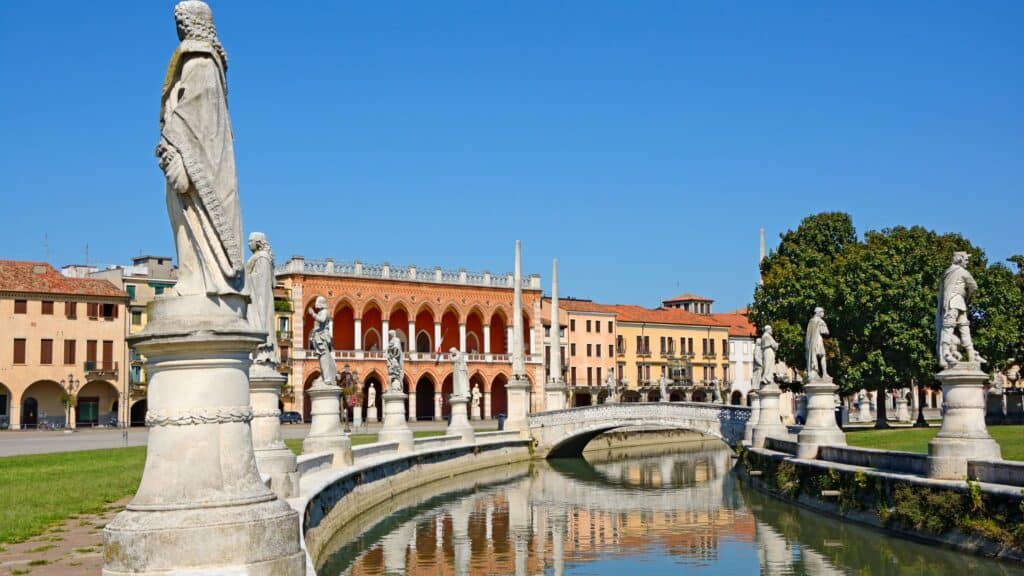I still remember standing in the Hoh Rainforest for the first time, completely speechless as ancient moss-draped trees towered above me like natural cathedrals.
Most people think you need a week to experience Olympic National Park properly, but I’m here to prove them wrong. With smart planning, you can study temperate rainforests, dramatic coastlines, and alpine peaks in just 48 hours.
This guide will show you exactly how I squeezed three distinct ecosystems into one incredible weekend. You’ll hike through thousand-year-old forests, hunt for agates on wild beaches, and soak in natural hot springs – all without feeling rushed.
Ready to experience one of America’s most diverse national parks? Let me walk you through my proven two-day itinerary that covers Olympic’s greatest hits and creates memories you’ll treasure forever.
Olympic National Park
Olympic National Park is a vast wilderness area that spans nearly one million acres across Washington State’s Olympic Peninsula. The park protects three distinct ecosystems:
- Temperate rainforests,
- Rugged mountain ranges
- Pristine Pacific coastline.
Visitors can study ancient forests filled with towering Douglas firs and Sitka spruces, some over 1,000 years old. The park features over 70 miles of wild coastline with dramatic sea stacks and tide pools teeming with marine life.
Mountain enthusiasts enjoy hiking through alpine meadows and scaling peaks like Mount Olympus. The park receives varying amounts of rainfall, creating lush temperate rainforests in some areas while maintaining drier conditions in others. Wildlife includes Roosevelt elk, black bears, and over 300 bird species.
Where is Olympic National Park Located?
Olympic National Park sits in the heart of Washington State’s Olympic Peninsula, approximately 100 miles west of Seattle. The park’s unique geography places it between the Pacific Ocean to the west and the Hood Canal to the east.
|
Key Location Details
|
The park’s isolated position on the peninsula creates its unique climate patterns, with the western slopes receiving over 140 inches of rainfall annually while the eastern rain shadow areas get less than 20 inches per year.
Time to turn that location knowledge into an unforgettable experience. Follow this guide to experience rainforests, mountains, and coastline in one incredible weekend.
Olympic National Park Quick Logistics Guide
Before you start planning those rainforest hikes and beach investigations, let’s cover the essential logistics that will make your Olympic National Park visit smooth and stress-free.
| Planning Category | Key Information |
|---|---|
| Park Entry | $30 per vehicle (7 days) • $80 Annual America the Beautiful Pass • No advance reservations needed |
| Getting There | 100 miles west of Seattle • Ferry from Seattle to Bainbridge Island • Drive Highway 101 around the peninsula |
| Cell Service | Limited or no service in most park areas • Download offline maps before visiting • Emergency phones at visitor centers |
| Gas & Food | Fill up in Port Angeles or Forks • Limited food options in the park • Bring snacks and water |
| Must-Have Permits | Wilderness camping requires permits • Fishing license needed • Some beaches need tribal permits |
| Transportation | Personal vehicle recommended • No shuttle service • Distances between attractions are significant |
| Park Entrances | North: Port Angeles (Hurricane Ridge) • West: Forks (Hoh Rainforest) • East: Hoodsport (Staircase) |
Olympic National Park: 2-Day Itinerary Guide
Ready to study these diverse ecosystems? Here’s how to make the most of your Olympic National Park experience in just two days.
Day 1: Rainforest and Coastal Exploration
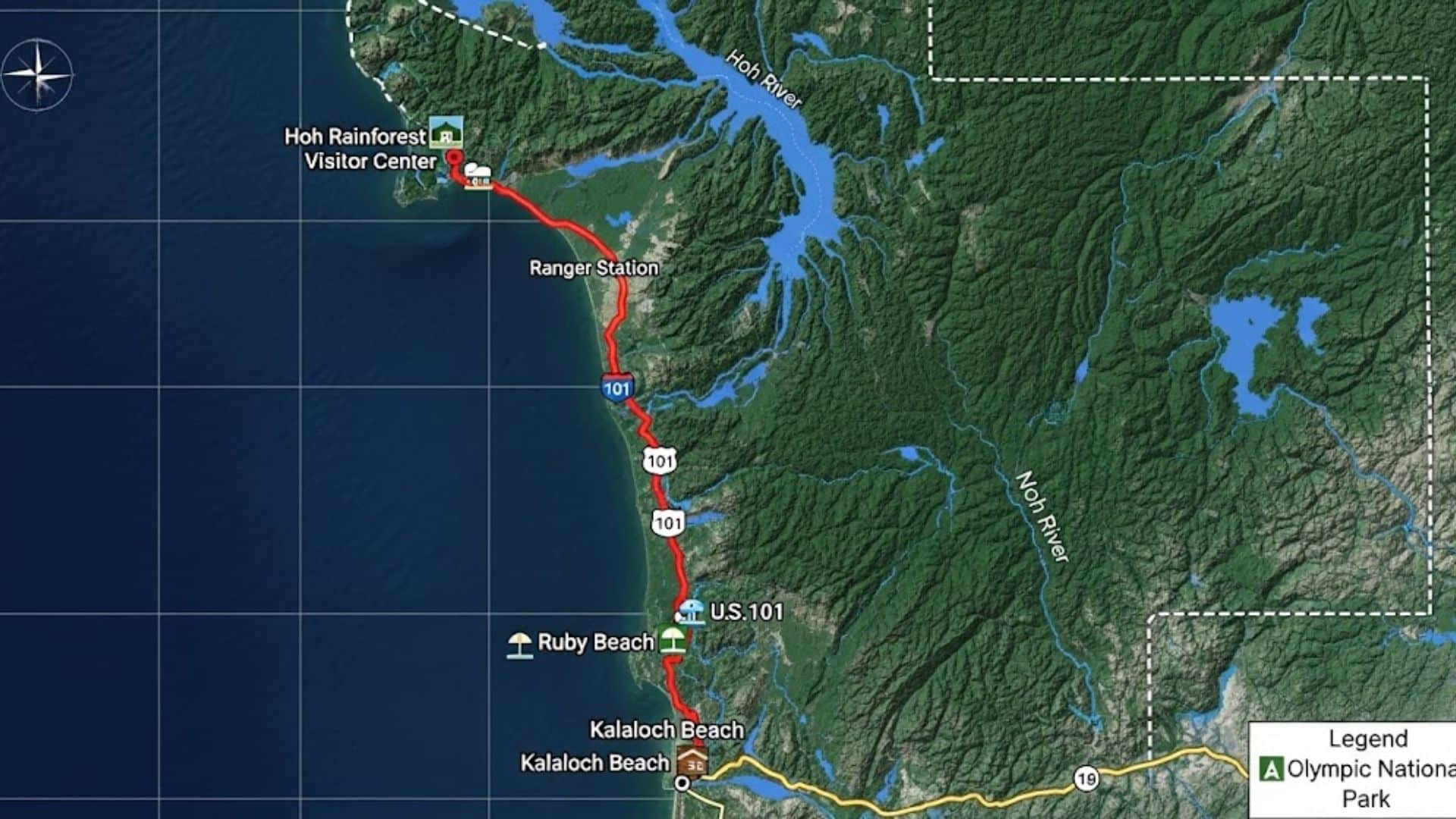
Morning (8:00 AM – 12:00 PM)
Start at the Hoh Rainforest
- Drive to Hoh River Valley (2.5 hours from Port Angeles)
- Hike the Hall of Mosses Trail (0.8 miles, easy)
- Experience towering old-growth trees covered in thick moss
- Spot Roosevelt elk grazing in meadows
- Take photos of the cathedral-like forest canopy
Alternative shorter option: Hoh River Trail (1-2 miles for gorgeous river views)
Afternoon (12:00 PM – 6:00 PM)
Ruby Beach Coastal Adventure
- Drive 30 minutes south to Ruby Beach
- Pack lunch to eat on the beach
- Analyze dramatic sea stacks and tide pools
- Search for colorful agates and driftwood
- Watch for seals and sea otters offshore
- Climb on massive driftwood logs for photos
Pro Tip: Check tide charts – low tide offers better tide pool investigation
Evening (6:00 PM – 8:00 PM)
Sunset at Kalaloch Beach
- Drive 10 minutes south to the Kalaloch Lodge area
- Watch a spectacular Pacific sunset
- Take an evening beach walk
- Stay overnight in Forks or Kalaloch Lodge
Day 2: Mountain Views and Hot Springs
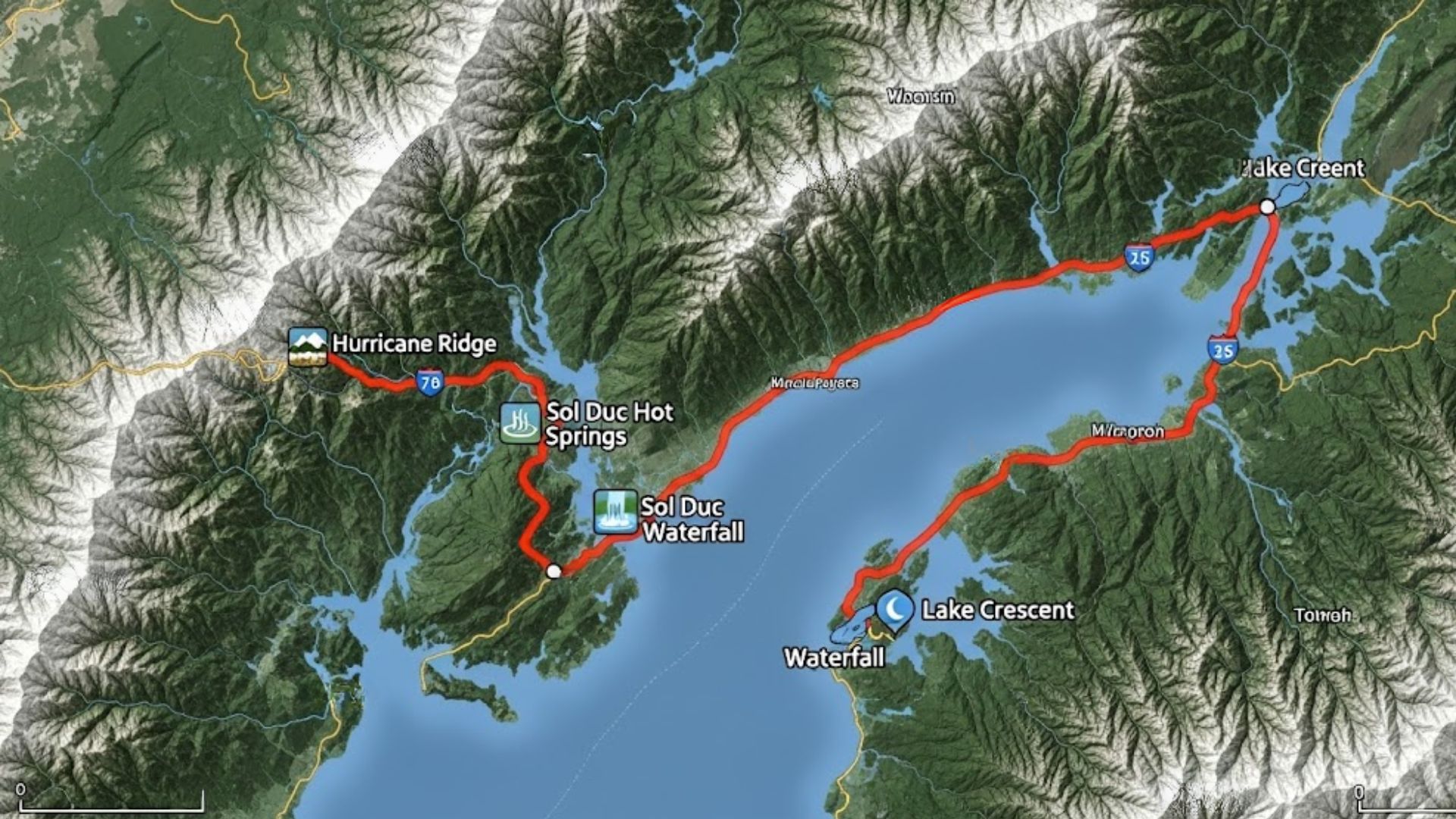
Morning (8:00 AM – 1:00 PM)
Hurricane Ridge Alpine Experience
- Drive to Hurricane Ridge Visitor Center (1.5 hours from Forks)
- Stop at the visitor center for maps and information
- Hike Hurricane Hill Trail (3.2 miles round-trip, moderate)
- Get panoramic views of the Olympic Mountains and Mount Olympus
- Spot wildflowers in the summer months
- Watch for black-tailed deer and marmots
Shorter option: Hurricane Ridge Nature Trail (1.6 miles, easy)
Afternoon (1:00 PM – 5:00 PM)
Sol Duc Hot Springs and Waterfall
- Drive 45 minutes to the Sol Duc area
- Hike to Sol Duc Falls (1.6 miles round-trip, easy)
- See the impressive 48-foot waterfall
- Optional: Soak in Sol Duc Hot Springs Resort pools (fee required)
- Relax tired muscles from hiking
Late Afternoon (5:00 PM – 7:00 PM)
Lake Crescent Drive
- Take a scenic drive along Lake Crescent
- Stop at Storm King Ranger Station
- Short walk to Marymere Falls (1.8 miles round-trip)
- Enjoy crystal-clear lake views
- Perfect ending to your Olympic experience
Two days barely scratches the surface of what Olympic National Park offers, but this itinerary ensures you experience the park’s most iconic features.
Pack your sense of experience and prepare for memories that will last a lifetime.
Where to Stay?
Olympic National Park offers diverse lodging options both inside and outside the park.
Inside the park, choose from historic Lake Crescent Lodge with vintage charm, oceanfront Kalaloch Lodge for storm watching, or Sol Duc Hot Springs Resort for post-hike relaxation. Camping options include Hoh River Campground in the rainforest and Kalaloch Campground with ocean views.
Gateway towns provide convenient bases: Port Angeles offers hotel chains and bed-and-breakfasts near Hurricane Ridge access. Forks provides cozy inns close to rainforest attractions and coastal beaches. Sequim features unique accommodations in the drier rain shadow area.
Booking tips: Reserve park lodges 6-12 months ahead for summer visits. Gateway towns offer more availability and dining options. Choose your location based on planned activities – Port Angeles for mountains, Forks for rainforest and coast.
Olympic National Park Packing Checklist
Packing for Olympic National Park requires preparation for multiple climates and activities. From rainforest hikes to beach investigations, having the right gear ensures comfort and safety during your visit.
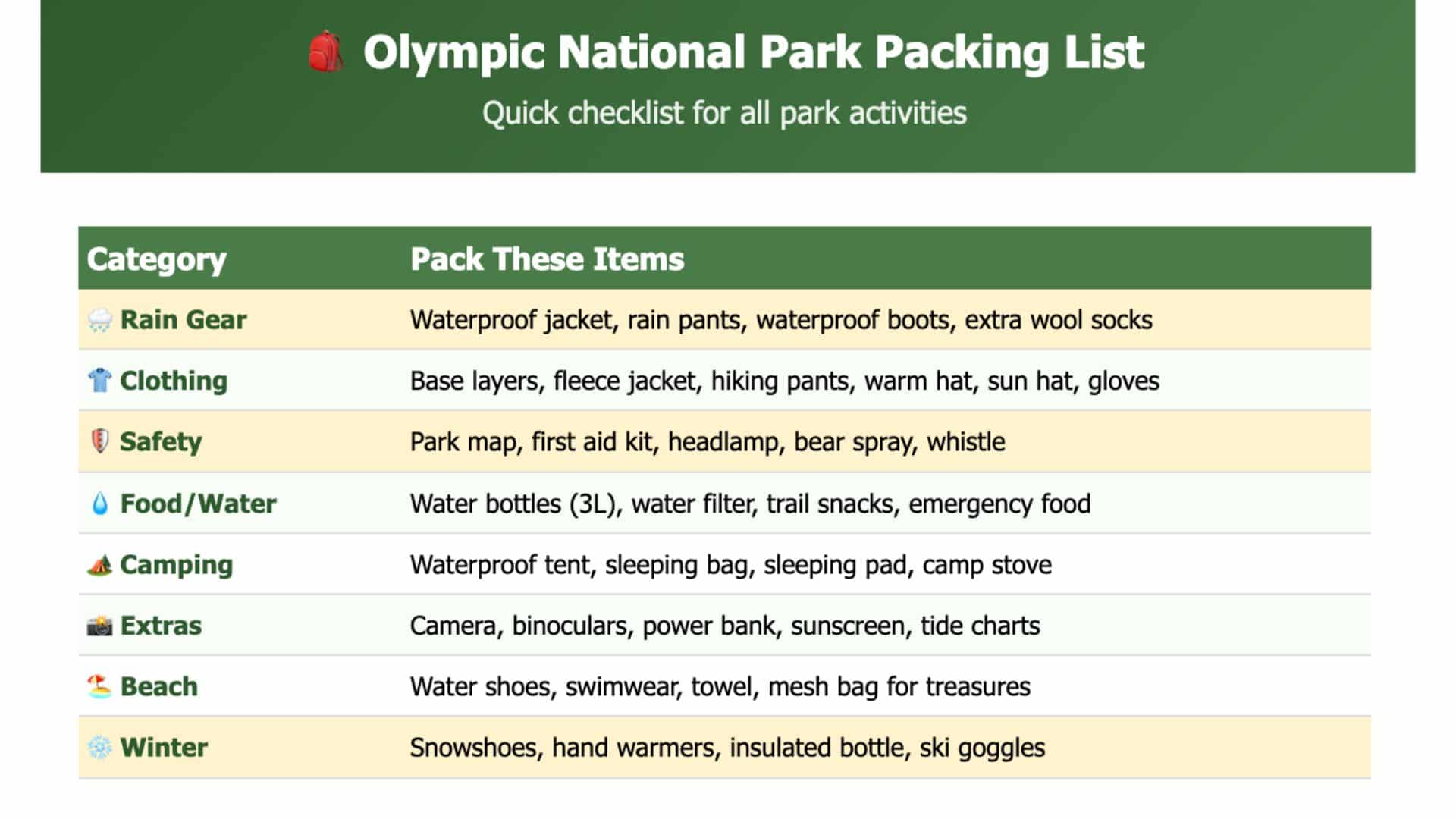
Remember that Olympic’s weather can change quickly, even during summer months. Pack layers and waterproof gear regardless of the forecast.
The west side receives significantly more rain than the east side, so adjust your packing list based on your planned activities and destinations within the park.
Final Thoughts
Two days in Olympic National Park will change how you see the Pacific Northwest forever. You’ve learned how to experience three distinct ecosystems without feeling rushed, from moss-covered rainforests to rugged coastlines and alpine meadows.
The memories you’ll create hiking through ancient forests and watching Pacific sunsets will stay with you long after you return home.
Start planning your trip now, book your accommodations early, especially for summer visits, and download those offline maps before you lose cell service.
What part of this itinerary excites you most?
The mystical Hoh Rainforest or the dramatic Ruby Beach coastline? Share your Olympic National Park plans in the comments below, and don’t forget to pack that rain gear. You’ll thank me later when you’re staying dry and comfortable while others get soaked!



